Testimony of
Paul P. Skoutelas
President and CEO
American Public Transportation Association
Hearing on “Surface Transportation Reauthorization: Public Transportation Stakeholders’ Perspectives”
Introduction
Chairman Crapo, Ranking Member Brown, and Members of the Committee on Banking, Housing, and Urban Affairs, on behalf of the American Public Transportation Association (APTA) and its more than 1,500 public- and private-sector member organizations, thank you for the opportunity to testify on “Surface Transportation Reauthorization: Public Transportation Stakeholders’ Perspectives”.
My name is Paul Skoutelas, and I am the President and Chief Executive Officer of APTA, an international association representing all modes of public transportation—bus, paratransit, light rail, commuter rail, subways, waterborne services, and high-performance intercity passenger rail.[1] APTA would like to share with the Committee some of the issues that are critical to our industry as we look to the next surface transportation authorization that will succeed the Fixing America’s Surface Transportation Act (FAST Act) (P.L. 114-94).
Public Transportation Gets Us There
Americans ride public transportation nearly 10 billion times a year, and every trip meets a need or provides an opportunity. Riders of all ages and incomes use public transportation to access education, career opportunities, and medical care in urban, suburban, and rural communities across the country. Since 1995, the number of trips taken on public transportation has increased 27 percent—growing faster than the U.S. population.
With more than 16 million additional commuters expected by 2030, U.S. roads will become even more congested.[2] Public transit provides a high-capacity mobility alternative, and it remains one of the most efficient and safest modes of travel. And it saves riders money. APTA estimates that a person who switches his or her daily commute from driving to taking public transportation can save $10,000 a year.
Yet, we still have more work to do to provide these benefits and access to opportunities to more communities—45 percent of Americans do not have access to public transportation.[3]
Traveling Safely to Your Destination
For the entire public transportation industry, safety is a core value—a non-negotiable operating principle and promise to our riders. The men and women responsible for managing and operating public transportation systems are fully committed to the safety of their systems, passengers, employees, and the general public. As a result of this overriding and sustained commitment to safety, traveling by public transportation is 10 times safer for passengers than traveling by car, and modest increases in transit ridership can cut traffic fatalities in half.[4]
Creating Jobs and Growing the Economy
Public transportation represents a $74 billion industry that directly employs more than 435,000 people and supports millions of private-sector jobs. More than $39 billion (55 percent) of transit expenditures flow to the private sector. For every $1 billion invested in public transportation, nearly 50,000 jobs are created or sustained across the entire economy, including in non-transit industries.[5] For every $1 invested in public transportation, approximately $5 in long-term economic return is generated.[6] Research has shown that investment in public transportation creates jobs in communities of all sizes throughout the country, including in smaller urban and rural areas where buses and railcars are often manufactured.
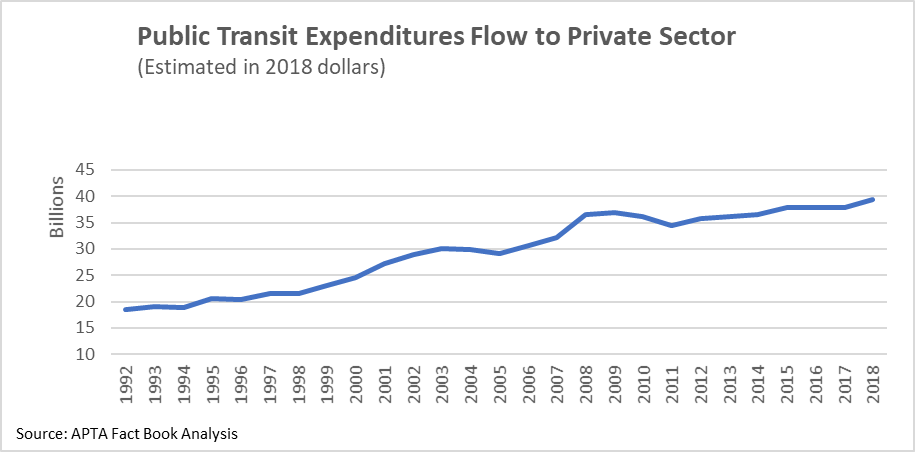
Moreover, the business community knows how important public transportation is for its employees—that is why so many businesses want to be located near public transportation and are actively engaged in partnerships with their local public transit systems. For example, Amazon’s decision to locate its new HQ2 in Arlington, Virginia, was in part influenced by the variety of public transportation options located in the area. Similarly, McDonald’s recently moved its headquarters from the Chicago suburbs to downtown. In addition, the public transportation industry provides investment opportunities across the country, ranging from manufacturing to design and construction, to operations and maintenance, to data management and technological innovation. Public transportation agencies rely on their private-sector partners to help deliver innovative transit projects efficiently and on schedule.
Providing Rural Access
Today, approximately 6,800 organizations provide public transportation through a variety of modes, with the majority operating in rural areas. According to Federal Transit Administration (FTA) data, there are 1,279 transit agencies operating in rural areas, and 928 transit agencies operating in urbanized areas. In addition, there are approximately 4,580 non-profit public transportation providers operating across the nation.
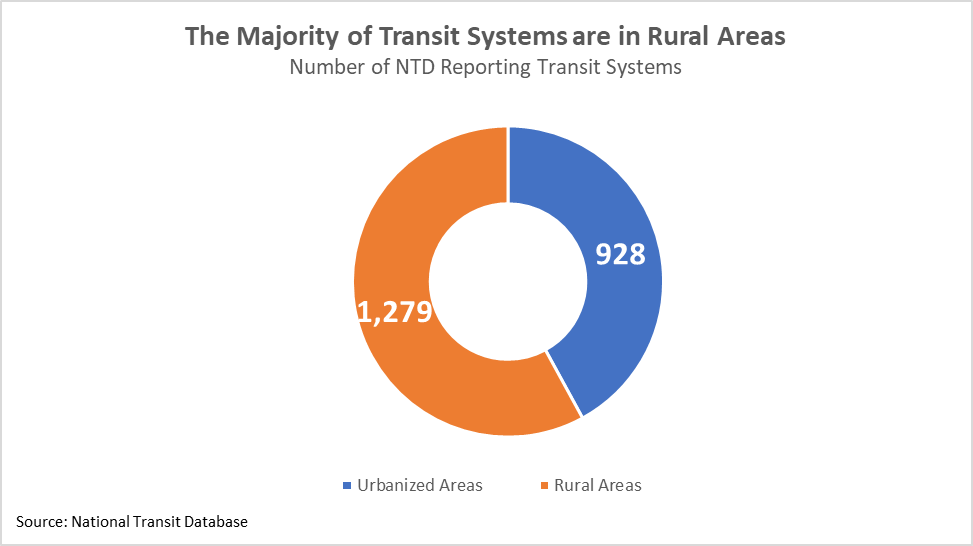
In rural areas, especially for seniors and people with disabilities, public transportation is a lifeline. Rural residents with disabilities rely heavily on public transit, taking approximately 50 percent more public transit trips than those without disabilities.[7]
Ridership in rural areas is estimated to be 125 million annual trips. Public transit is critical for connecting users to needed services, including access to medical care for the almost five million U.S. veterans living in rural areas and for providing Medicaid recipients with non-emergency medical transportation (NEMT) services to mental health, substance abuse, chemotherapy, dialysis, and other critical chronic and preventive care appointments. Without NEMT, millions of Americans would not be able to access these important medical services.[8]
APTA’s Top Three Priorities
On October 12, 2019, APTA’s Board of Directors adopted APTA’s Recommendations on Surface Transportation Law. Our top three priorities are premised on erasing the infrastructure deficit, rebuilding and expanding our public transportation systems to best meet the needs of today’s commuting public and future demands, and enhancing our nation’s economic competitiveness. APTA calls for a total federal investment of $178 billion over six years for public transit and passenger rail. If enacted, this investment will create or sustain more than two million jobs.
-
Highway Trust Fund Solvency and Long-Term, Increased Investment
APTA calls for federal investment of $145 billion over six years to fund critical projects that will repair, maintain, and improve our public transit systems today and in the future. We have based this Recommendation on the funding needed to provide the federal share necessary to eliminate the transit state-of-good-repair backlog, which the U.S. Department of Transportation (DOT) has determined is more than $99 billion and growing.[9] Additionally, our plan would fully fund each of the projects currently in the Capital Investment Grants (CIG) pipeline, and fund other key priorities outlined below.
It has been more than 25 years since Congress last raised the federal fuel taxes that primarily support the Highway Trust Fund, and the purchasing power of this revenue has decreased by more than 40 percent over that time. Current revenues deposited into the Trust Fund are insufficient to support the existing federal highway and public transportation programs without significant general fund contributions. This status quo is unsustainable and tough choices need to be made by Congress.
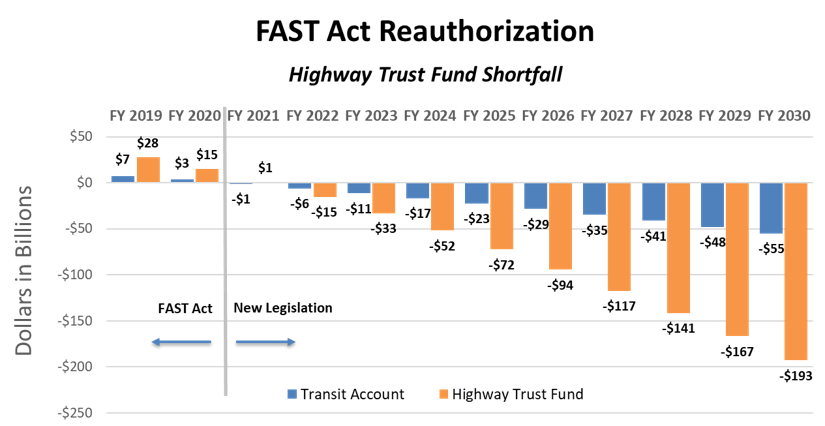
In January 2018, the U.S. Chamber of Commerce proposed a plan to increase the federal motor vehicle fuel user fee by five cents per year over five years (Total: 25-cent increase). APTA strongly supports this plan. We also support any other reasonable, bipartisan plan to increase dedicated revenues to the Highway Trust Fund.
-
Reestablish a 40-40-20 Capital Investment Ratio Among Key Programs
APTA calls on Congress to reestablish a 40-40-20 capital investment ratio among the CIG, State of Good Repair, and Buses and Bus Facilities program. Historically, Congress allocated funding on a 40-40-20 basis among the CIG, State of Good Repair and Buses and Bus Facilities programs. The 40-40-20 ratio was maintained in authorizing law from 1987 through 1998, and for guaranteed authorizations from 1999 through 2003. Recent authorization acts have not maintained that ratio and, as a result, the Buses and Bus Facilities program has received less funding.
Our Recommendations provide significant increases for the CIG, State of Good Repair and Buses and Bus Facilities programs. In growing each program, APTA believes that a relative distribution of 40 percent for CIG, 40 percent for State of Good Repair, and 20 percent for Buses and Bus Facilities is the fairest allocation of funding for these three capital investment programs.[10] To achieve this objective, APTA proposes that the Buses and Bus Facilities program grow at a higher rate in the early years of the authorization period.
-
Mobility Innovation and Technology Initiative
APTA calls for the creation of a new Mobility Innovation and Technology Initiative to introduce cutting-edge technologies and integrate new service-delivery approaches and mobility options in the transit marketplace. We need to invest in public transportation innovation that meets the evolving needs of our residents and the places they live. Advances in technology have allowed vehicles to operate with increased autonomy and efficiencies, and data capabilities enable effortless trip planning and streamlined information sharing. Today, there are more transportation options than ever—commuters may ride a shared scooter to a bus stop or take rideshare to a rail station.[11]
Our members are redefining mobility in their communities and using technology to ensure greater reliability, expand services, and improve customer experiences. We believe that smart investments in demonstration and implementation projects today will meet the mobility demands of our riders in the future.
Investing in Public Transportation Yields Great Benefits
Americans across the country in all types of communities are demanding quality public transportation, and increased investment in all modes is necessary to meet that need. And, the money will be put to good use by meeting state-of-good-repair needs, ensuring equity and opportunity, and providing a down payment toward cleaner air.
Meeting State-of-Good-Repair Needs
With a state-of-good-repair backlog of more than $99 billion and growing, support from all levels of government is sorely needed. This need is most evident as most transit agencies are operating vehicles beyond their useful lives. For buses, the average fleet age has increased in recent years. Of the 123,000 transit buses and vans, almost one in five are not in a state of good repair. For rail transit vehicles, the average fleet age is close to 20 years.
Just this month, the New York City transit system retired the last of its R-42 subway cars—51 years after they started service.[12] In San Antonio, VIA Metropolitan Transit had a number of vehicles in its fleet mix that were at or over 1,000,000 miles! VIA is beginning to replace its aging fleet by purchasing hundreds of buses. In addition to reducing operating costs, the fleet replacement will allow the agency to carry out planned service enhancements.
Lack of federal funding for replacing and rehabilitating transit buses has also greatly impacted small operators. The Centre Area Transportation Authority (CATA) in State College, Pennsylvania reports that it is the new norm to operate buses that are twice the FTA-determined useful life of 12 years. The maintenance costs associated with keeping such vehicles safe and on the road has significantly impacted CATA’s maintenance budget over the past several years, and it is oftentimes left to find bus parts from other transit systems or by scavenging junkyards.
Along with guideway elements, systems, stations, and facilities, billions of dollars will be needed to bring all these systems to a state of good repair. Investments in the state of good repair of a system is an investment in safety. Public transportation agencies have limited budgets, and many are using buses, railcars, or other infrastructure that are well beyond their useful lives. Our agencies will continue to work every day to sustain and improve the safety and reliability of their systems. Federal investment in our infrastructure is a crucial element to achieving that goal.
Providing Equity and Opportunity
Public transportation provides a ladder to opportunity for millions of Americans and is one of the most direct ways to address income inequality. One out of five transit users are from households earning less than $15,000.[13] One of the fastest growing job segments in the U.S. is late-shift work that begins between 4 p.m. and 6 a.m. Late-shift workers make 14 percent less than their daytime peers and are more likely to be people of color.[14] Expanding public transit service to the late shift is critical to increasing workforce opportunities. Although late-shift public transit commuters represent a small share of today’s late-shift workforce, they already have a large economic footprint: These workers bring home $28 billion in wages per year and facilitate an estimated $84 billion in annual sales. Furthermore, there is significant demand for housing near transit which points to a need for more transit-served communities.[15]
Toward Cleaner Air
Investing in public transit is an investment toward cleaner air. There is a dramatic shift underway in our industry and APTA members are at the forefront of transitioning to cleaner fuel sources.[16] Currently, more than 56 percent of transit buses use alternative fuels, with more than 17 percent of those vehicles utilizing hybrid-electric technology. Today, there are nearly 300 electric buses in service with hundreds more electric buses on order.
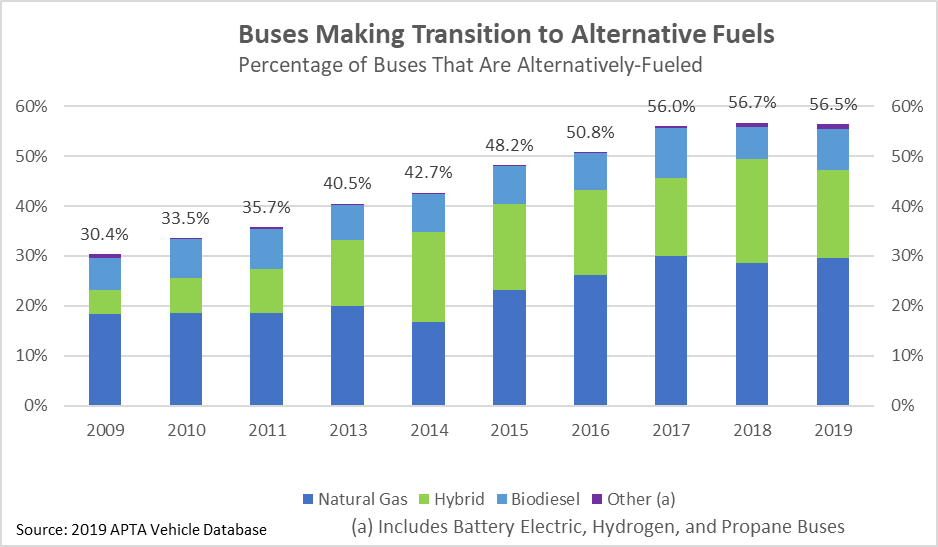
Communities that invest in public transit reduce the nation’s carbon emissions by 37 million metric tons annually. Overall, public transportation saves the U.S. 4.2 billion gallons of gasoline annually. As new and cleaner technologies become available, the public transit industry is poised to lead in adaptation.
There are always challenges to adoption of new technologies. For public transit agencies transitioning to electric buses, these challenges have included larger up-front costs and the range of the vehicles. Public transit agencies are beginning to integrate zero-emission buses into their fleets and are setting goals for 100 percent zero-emission bus fleets in future years. Federal grant programs have been vital resources for public transit agencies nationwide in acquiring new zero-emission vehicles. APTA urges significant funding increases for programs, such as Buses and Bus Facilities competitive grants and Low or No Emission competitive grants, that can support zero-emission infrastructure.
Other Key Priorities
Capital Investment Grants Program
APTA strongly supports the CIG program. Capital Investment Grants provide critical investments for new and expanded subways, light rail, commuter rail, streetcars, and bus rapid transit (BRT), among others. There are currently 12 projects with executed full funding grant agreements and 50 more CIG projects are in FTA’s pipeline, requesting nearly $25 billion of CIG funding in coming years.
As illustrated below, over the past decade, 28 states have benefited from the CIG program or are in the current pipeline. From BRT projects in Minnesota, Nevada, and Pennsylvania, to commuter rail projects in Texas, and light rail projects in Arizona, North Carolina, and Utah, public transportation projects that are funded through the CIG program are an essential component of addressing the mobility demands of growing communities.
The economic benefits of these projects reach a far greater span than just the project location itself. A CIG project in California may be receiving vehicles, parts, or materials from a supplier in Alabama, Georgia, Kansas, or Pennsylvania.[17] These projects also represent thousands of construction jobs, transit equipment manufacturing jobs, and jobs associated with parts and materials suppliers and worker spending. Moreover, after a new transit line is constructed and operational, there are ongoing, permanent economic growth and development impacts enabled by the transportation improvements and associated economic productivity gains.[18]
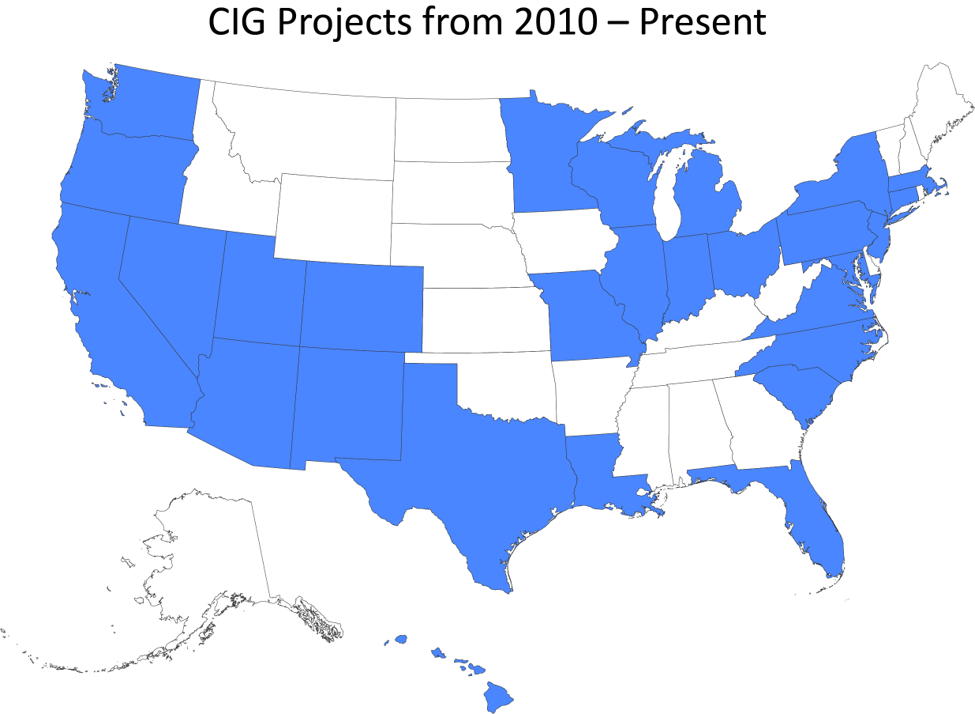
Unfortunately, the CIG program has shifted from an efficient public transportation capital program that can build good projects while protecting taxpayer dollars to a grant program that has requirements above and beyond that of comparable modes—such as highway grant programs. Today, a CIG project sponsor faces almost 60,000 words of federal statutory law, regulations, and administrative guidance under the program. Comparatively, a Federal-aid Highway INFRA Grant applicant faces less than one quarter of the statutory language of the CIG program and no specific regulations. These burdensome requirements cause significant delay in project approvals, which result in considerable increases in project costs prior to construction.
APTA strongly urges the Committee to conduct a zero-based review of the CIG program to assess all statutory, regulatory, and other administrative requirements.
Passenger Rail Investment
Finally, APTA’s commuter rail members are working to make commuter rail even safer by installing and implementing Positive Train Control (PTC), a complex signaling and communications technology that provides a critical safety overlay on top of already safe commuter rail systems. APTA’s commuter rail members are committed to full implementation of PTC in 2020. PTC will cost commuter rail operators approximately $4.1 billion to implement, and almost 90 percent of these costs are being borne by state and local governments and agencies. In addition, PTC will cost an estimated $160 million each year to operate and maintain. For publicly funded agencies that rely on federal, state, and local funding, as well as passenger fares to operate their service, these costs are staggering. APTA’s Recommendations call for specific set asides for commuter rail from the Consolidated Rail Infrastructure and Safety Improvements grants program to provide specific funding for operations and maintenance of PTC ($160 million per year; $1 billion over six years) as well as Passenger Rail-Highway Grade Crossing Grants ($250 million per year; $1.5 billion over six years).
APTA calls on Congress to create a Passenger Rail Trust Fund to fund these commuter rail initiatives and significantly increase passenger rail investment. Continued dedication to intercity passenger rail programs is critical to providing access to citizens across the nation, especially in rural areas.
Conclusion
On behalf of APTA, thank you for including us in this important hearing as the Committee develops the next surface transportation bill. In each of your states, public transportation provides very real benefits to your constituents, their communities, and the national transportation network. To maintain our position as a global leader, our country needs more job creation, a stronger economy, a cleaner environment, and more opportunity – and significant investments in public transportation gets us there.
[1] APTA members include public transportation systems; planning, design, construction, and finance firms; product and service providers; academic institutions; state transit associations; and state departments of transportation.
[2] APTA, The Transformation of the American Commuter (December 2018).
[3] Census Bureau, American Housing Survey (2013).
[4] See APTA, Public Transit Is Key Strategy in Advancing Vision Zero, Eliminating Traffic Fatalities (August 2018).
[5] APTA, Economic Impact of Public Transportation Investment—2019 Update (February 2020). Public transportation can also enhance the productivity of industries not directly associated with transit, such as the technology industry.
[6] Id.
[7] APTA, Public Transportation’s Impact on Rural and Small Towns (2017).
[8] APTA is opposed to any changes to the NEMT program that would make it optional for states to provide this critical transportation service. See Department of Health and Human Services, Fiscal Year 2021 Budget in Brief (February 10, 2020).
[9] DOT, Status of the Nation’s Highways, Bridges, and Transit, Conditions and Performance (November 2019) (hereinafter referred to as the DOT Report).
[10] APTA’s Recommendations: Authorization Funding Table (attached as Appendix A) is the roadmap to achieve the appropriate balance among the three programs.
[11] According to The Transformation of the American Commuter, 77 percent of Americans say public transportation is the backbone of a multi-transit lifestyle. APTA is leading the charge to support public transportation agencies’ efforts to implement innovative mobility management strategies, while utilizing business models originating in the private sector.
[12] See Progressive Railroading, NYCT retires 1960s rail cars (February 13, 2020).
[13] APTA, Who Rides Public Transportation (January 2017).
[14] APTA, Supporting Late-Shift Workers, Transportation Needs and the Economy (September 2019).
[15] APTA, The Real Estate Mantra—Locate Near Transit (October 2019).
[16] APTA, Public Transit Leading in Transition to Clean Technology (November 2019). Transitioning a fleet to electric buses requires significant work, planning, and negotiation with utilities to ensure that the infrastructure and capacity exist to support the fleet. There are numerous examples of transit agencies adopting these new technologies, each with a different process and relationship with their local utilities and with infrastructure providers.
[17] See APTA Rail Manufacturing and Bus Manufacturing schematics (attached as Appendix B).
[18] APTA, Economic Implications from Proposed Public Transportation Capital Funding Cuts (April 2017).



